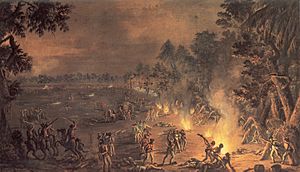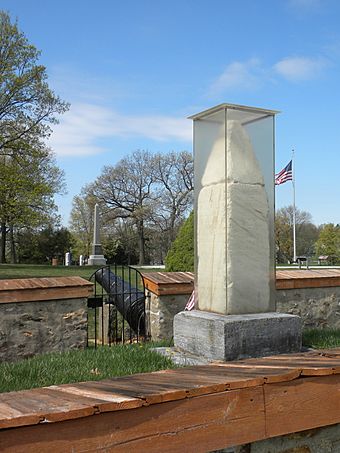Battle of Paoli facts for kids
Quick facts for kids Battle of Paoli |
|||||||
|---|---|---|---|---|---|---|---|
| Part of the American Revolutionary War | |||||||
 A Dreadful scene of havock, Xavier della Gatta, 1782 |
|||||||
|
|||||||
| Belligerents | |||||||
| Commanders and leaders | |||||||
| Strength | |||||||
|
2,500 men
|
1,200 men engaged 600 in support 2 miles away |
||||||
| Casualties and losses | |||||||
| 201 killed or wounded 71 captured |
4 killed, 7 wounded |
||||||
|
Paoli Battlefield Site and Parade Grounds
|
|

The present-day monument at the site of the battle
|
|
| Location | Roughly bounded by Warren, and Monument Aves., and Sugartown Rd., Malvern, Pennsylvania |
|---|---|
| Area | 62.2 acres (25.2 ha) |
| Built | 1817, 1877 |
| Architect | John T. Windrim, Palmer C. Hughes |
| Architectural style | Colonial Revival, Late 19th and 20th century Revivals |
| NRHP reference No. | 97001248 |
| Added to NRHP | October 23, 1997 |
The Battle of Paoli, also called the Paoli Massacre, was a surprise attack during the American Revolutionary War. It happened on September 20, 1777, near what is now Malvern, Pennsylvania.
After losing battles at Brandywine and the Clouds, General George Washington left some troops behind. These soldiers, led by Brigadier General Anthony Wayne, were supposed to watch the British army. They also aimed to bother the British as they moved toward Philadelphia, the capital city.
On the night of September 20, British forces launched a surprise attack. Major General Charles Grey led the British. They attacked Wayne's camp near the Paoli Tavern. Not many American soldiers died, but people claimed the British didn't take prisoners. This led to the event being called the "Paoli Massacre."
Contents
Why Did the Battle of Paoli Happen?
After the Americans lost the Battle of Brandywine, General Washington had two main goals. He wanted to protect Philadelphia from the British army. He also needed to get more supplies and weapons. These were stored at a furnace in Reading, Pennsylvania.
Washington first moved his army across the Schuylkill River. This river could protect both Philadelphia and the supply areas. But then he decided to cross back to face the British. They hadn't moved much since Brandywine.
After another battle was stopped by bad weather, Washington crossed the river again. He left General "Mad" Anthony Wayne's division behind. Wayne's orders were to follow the British. He was to try and capture their supply wagons.
Wayne thought the British didn't know where he was. So, he set up his camp very close to their lines. His division had about 1,500 soldiers. Another 2,100 less experienced troops, called militia, were camped about one mile away. These militia were led by William Smallwood.
The British heard rumors that Wayne was nearby. General Howe sent scouts to check. They found Wayne's camp near the Paoli Tavern. Since it was only four miles from the British camp, Howe quickly planned an attack.
How the Battle Unfolded
At 10 p.m. on September 20, Major General Charles Grey led his British troops. They marched from their camp to attack Wayne's soldiers. The battle is named after the General Paoli Tavern, which was nearby.
General Grey wanted to make sure the Americans weren't warned. He ordered his soldiers to attack with bayonets only. Their muskets were unloaded. This way, there would be no loud gunshots. This earned him the nickname "No Flints" Grey. However, one officer was allowed to have his men's muskets loaded.
The British forces had a local blacksmith guide them. They approached the American camp from a wood. This helped them achieve a complete surprise attack. They rushed into the camp in three waves.
Wayne's soldiers were completely unprepared. They quickly fled from their camp. The British chased after them. Near the White Horse Tavern, the British also found Smallwood's militia. They quickly defeated those troops too.
The British had very few losses. Only 4 of their soldiers were killed and 7 were wounded. They had managed to defeat an entire American division. Historians say 53 Americans were buried on the battlefield. Another 8 Americans were buried at a nearby church. The British also captured 71 prisoners. Many of these were badly wounded and had to be left behind. In total, 272 American soldiers were killed, wounded, or went missing.
What Happened After the Battle?
An official investigation looked into General Wayne's actions. They found he hadn't done anything wrong on purpose. But they said he had made a mistake in how he set up his camp. Wayne was very angry and demanded a full military trial. On November 1, a group of 13 officers said Wayne had acted with honor.
The Battle of Paoli became well-known because of what people said happened. Eyewitnesses claimed that the British used bayonets on American soldiers who tried to surrender.

Because of these claims, Wayne's soldiers wanted revenge. "Remember Paoli!" became their battle cry. They used it in later battles, like the Battle of Germantown and the Battle of Stony Point.
There's a story that British soldiers dyed their hat feathers red. They did this so Americans could easily spot them. This was a way to show they were ready for a fight. Later, some British regiments wore red distinctions on their hats to remember this.
The Paoli Monument
In 1877, a large granite monument was built at the battle site. It replaced an older monument from 1817 that was falling apart. The new monument is 22.5 feet tall. It has words carved on all four sides.
This monument is located in a park in Malvern, Pennsylvania. The park is called the Paoli Battlefield Site and Parade Grounds. It was added to the National Register of Historic Places in 1997. The site includes the battlefield itself and the parade grounds. It also has the 1817 monument, the 1877 obelisk, and other memorials. There is also a caretaker's house and garage from 1922.



